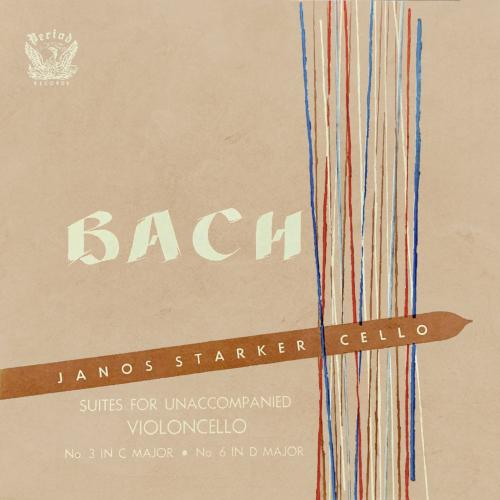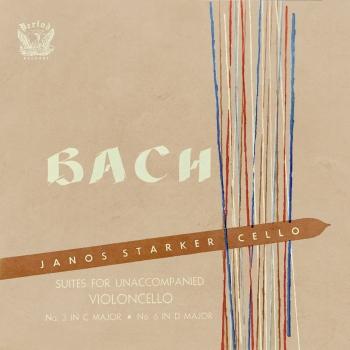
Suites For Unaccompanied Violoncello (Remastered) Janos Starker
Album info
Album-Release:
1952
HRA-Release:
07.12.2021
Label: Period Records
Genre: Classical
Artist: Janos Starker
Composer: Johann Sebastian Bach (1685-1750)
Album including Album cover
- Johann Sebastian Bach (1685 - 1750): Cello Suite No.3 in C Major, BWV 1009:
- 1 Bach: Cello Suite No.3 in C Major, BWV 1009: I. Prelude 03:48
- 2 Bach: Cello Suite No.3 in C Major, BWV 1009: II. Allemande 03:11
- 3 Bach: Cello Suite No.3 in C Major, BWV 1009: III. Courante 01:57
- 4 Bach: Cello Suite No.3 in C Major, BWV 1009: IV. Sarabande 02:45
- 5 Bach: Cello Suite No.3 in C Major, BWV 1009: V. Bourree. VI. Bourree 03:08
- 6 Bach: Cello Suite No.3 in C Major, BWV 1009: VII. Gigue 01:56
- Cello Suite No.6 in D Major, BWV 1012:
- 7 Bach: Cello Suite No.6 in D Major, BWV 1012: I. Prelude 04:06
- 8 Bach: Cello Suite No.6 in D Major, BWV 1012: II. Allemande 06:36
- 9 Bach: Cello Suite No.6 in D Major, BWV 1012: III. Courante 02:16
- 10 Bach: Cello Suite No.6 in D Major, BWV 1012: IV. Sarabande 03:13
- 11 Bach: Cello Suite No.6 in D Major, BWV 1012: V. Gavotte I. VI. Gavotte II 03:28
- 12 Bach: Cello Suite No.6 in D Major, BWV 1012: VII. Gigue 02:17
Info for Suites For Unaccompanied Violoncello (Remastered)
Today it is difficult to understand that despite the tremendous Bach renaissance that took place in the 19th century many compositions by the Cantor of St. Thomas’s Church in Leipzig had been underrated. The Cello Suites, for example, have been regarded for almost 300 years as purely a set of tricky etudes that every virtuoso in the making simply must tackle. What recording engineers and their equipment can bring to the ears is quite astounding. So it was back in the Thirties with Pablo Casal’s legendary recording against which every cellist is measured today and to whose perfection he aspires.
Janos Starker’s recording of the Suites from 1965 makes a lasting impression on the listener, even when compared with other recordings from the digital era, and even record producers who are well used to recorded excellence have been highly impressed. For Charlotte Gilbert of the Mercury record label, these recording sessions were one of five truly great events in all her 20 years of recording experience.
Without a doubt, Starker allows his instrument to resound freely but without forcing the tone. Starker’s full-bodied sound and technical brilliance are complemented by his finely chiselled interpretation that lends immense expression to Bach’s thrilling harmony and verve to the strict rhythmic construction of the movements. Just listen to his organ-like double-stopped passages, the eloquent dialogues, and the pure excitement created by his highly individual treatment of tempo. Then you will surely agree with the often-quoted paradox that Bach’s Cello Suites are ‘polyphony for a solo instrument’. (Speakers Corner Records)
János Starker, cello
Digitally remastered
János Starker
born to a father of Polish descent and a Ukrainian mother, gave his first performances at the age of six. Two years later he engaged in his first teaching activities, demonstrating enormous precocity, and had five pupils by the age of twelve. At fourteen he gave his professional debut playing the Dvořák Concerto, deputising at just three hours’ notice. He attended the Liszt Academy from the age of eleven to study with Adolf Schiffer (a pupil and successor of Popper), and cited as strong influences Leo Weiner, Zoltán Kodály, Béla Bartók and Ernő Dohnányi, who all taught there. Starker left the Academy as World War II broke out and spent three months in a Nazi camp, but avoided being pressed into hard labour and survived, unlike his two violinist brothers.
After the war Starker took up a succession of principal cello roles, initially with the Budapest Opera and Philharmonic Orchestras, moving briefly to Vienna in 1946 to prepare for the Geneva Cello Competition which he lost, rather ironically, to his pupil Eva Janzer. Around this time he underwent a process of re-evaluating and rebuilding his technique, much like Menuhin whom he had seen in concert whilst the latter was in his darkest period of self-doubt. One product of Starker’s reflections was An Organized Method of String Playing, a programme which he taught around the world from 1955 onwards and published in 1965, in which he lays out every element of technique and physical preparation in great detail.
After spending a year in Paris (where he mastered Kodály’s supremely difficult Op. 8 Sonata for which he won the Grand Prix du Disque) Starker entered the United States in 1948 and took up a succession of orchestral posts, later moving to Indiana University and restarting his solo career in the late-1950s. He subsequently became one of the most recorded artists in the world, his discography spanning virtually the entire cello literature, including several issues of the Bach Cello Suites – initially Nos. 1, 3, 4 and 6 during 1950–1952, and complete sets on four further occasions. A number of composers wrote for him including Miklós Rózsa, Jean Martinon and Bernhard Heiden. In the last decade or so of his life Starker concentrated more upon teaching; his students included Tsuyoshi Tsutsumi and Maria Kliegel.
In all repertoire Starker’s sound is characterised by a clear tone and an almost encyclopedic technical mastery, which has been the subject of a number of television documentaries and magazine articles. Like many other modern players he eschews audible shifting, but also avoids wide vibrato (which he sees as a cover for poor intonation); the result is a restrained yet engaging sound. Arguably, some of his high-register playing can sound strained (as in the C.P.E. Bach concerto here from 1996), but this is a minor cavil. His recordings include a reflective Kodály Op. 4 Sonata (1952), some stylish Haydn from 1987 and an almost objective approach to the heartfelt but introspective Hovhaness and Prokofiev works (1999 and 1956 respectively), whilst David Diamond’s Kaddish (1991) shows his more overtly impassioned side. Although his playing of eighteenth- century music may seem old-fashioned to ears now attuned to historically-informed practices, his 1988 Popper performances are superbly crafted, displaying his bullet-proof technical equipment. Starker’s playing is difficult to epitomize, perhaps one of the highest compliments that can be paid to an intelligent and sensitive musical artist.
This album contains no booklet.









